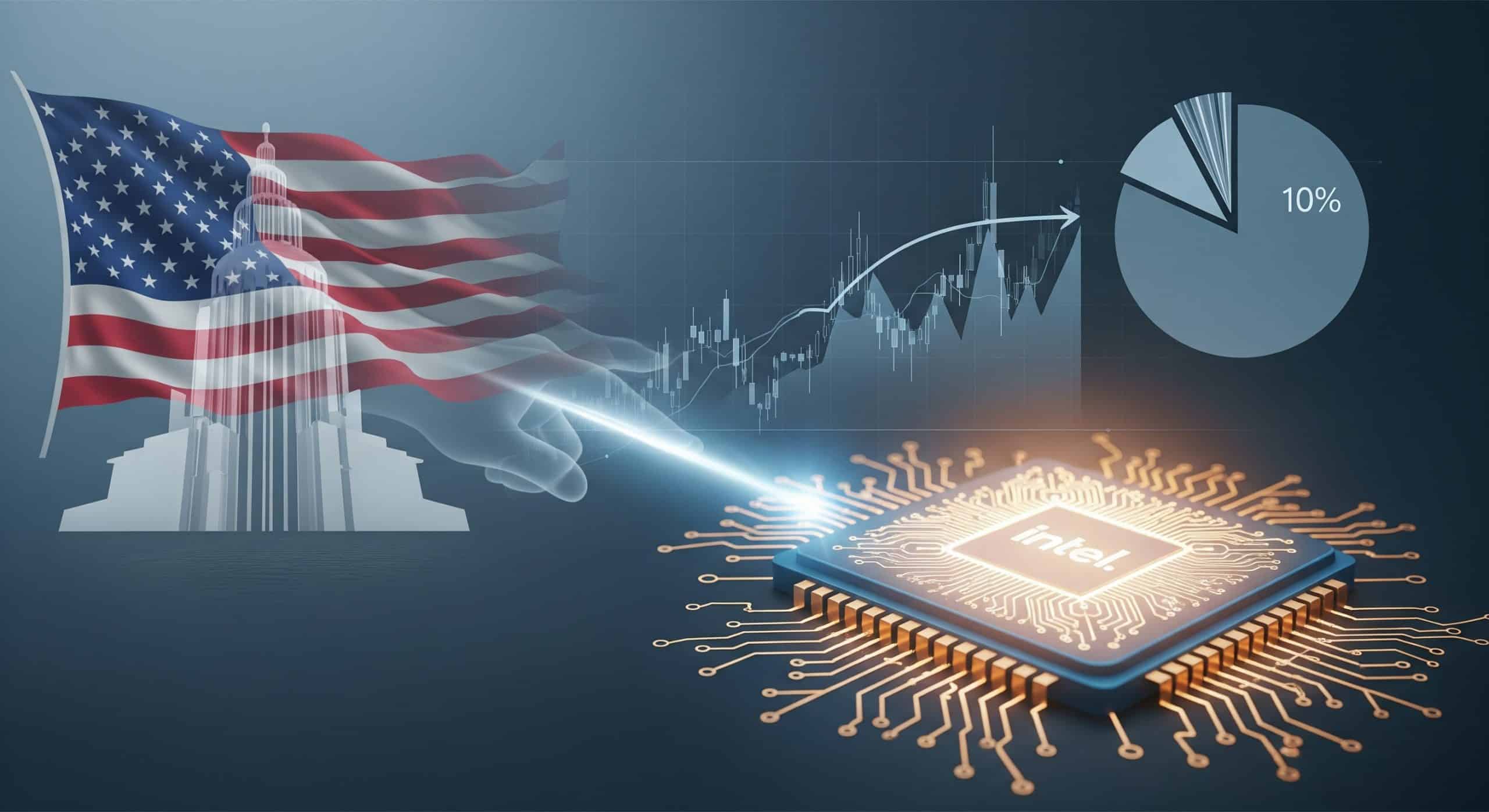Key Points:
- Washington is reportedly considering converting CHIPS Act grants into a direct equity stake in Intel.
- A potential 10% government ownership would reshape Intel’s financial and strategic positioning.
- The move could trigger ripple effects across the semiconductor industry and raise governance concerns.
A Strategic Shift in U.S. Industrial Policy
According to recent reports, the Trump administration is evaluating an unprecedented move to convert portions of CHIPS Act subsidies into an equity position in Intel (NASDAQ: INTC). The potential stake could reach as much as 10% of the company’s market capitalization, marking one of the most direct interventions of the U.S. government in a publicly traded technology leader.
The CHIPS Act, enacted to strengthen America’s semiconductor manufacturing base, was originally designed as a subsidy program through grants and tax incentives. Converting those grants into equity fundamentally alters the program’s intent: rather than serving as passive financial support, the government would become a direct shareholder in Intel. This approach would align public policy with corporate governance, embedding the state more deeply in the semiconductor supply chain.
Implications for Intel’s Balance Sheet and Market Position
For Intel, such a transaction could dramatically improve its balance sheet. Equity support, rather than debt financing, reduces leverage and provides greater financial flexibility to fund its ambitious foundry expansion plans. With tens of billions already allocated toward new fabrication plants in Arizona and Ohio, the company requires steady capital to maintain competitiveness against Taiwan Semiconductor Manufacturing Company (TSMC) and Samsung.
A government equity stake would also deliver a powerful psychological boost to investors. It signals that Washington considers Intel a strategic national asset, effectively underpinning the company’s market valuation. In practice, this could trigger a sharp rally in Intel’s stock price, as investors price in reduced financial risk and stronger state backing.
Broader Impact on the Semiconductor Sector
If realized, the government’s move would send shockwaves across the semiconductor industry. A direct stake in Intel would represent more than financial aid; it would be a strategic declaration of industrial policy. Rivals and suppliers alike would view Intel as enjoying unparalleled government support, potentially prompting similar measures for other U.S. chipmakers.
Moreover, this action could shift global competition. China has long funneled state capital into its own semiconductor champions, and the U.S. entering the equity game would escalate the industrial arms race. Markets could anticipate new layers of geopolitical competition as semiconductors remain the backbone of both technological innovation and national security.
Risks of Political Overreach
Despite its advantages, the plan carries risks. A 10% government stake would inevitably raise questions about Intel’s independence. Shareholders might fear political influence over strategic decisions, ranging from plant locations to international partnerships. Additionally, governance experts warn that government ownership in a publicly traded company could deter private investors concerned about regulatory overreach.
Another risk involves precedent. Should Washington acquire equity stakes in other corporations under the guise of strategic importance, markets may interpret this as creeping nationalization, complicating the investment landscape. Balancing financial support with corporate autonomy will be a critical challenge if the policy proceeds.
Market Outlook
Even before any official confirmation, the mere prospect of government equity involvement in Intel has already introduced heightened volatility. Traders are recalibrating their expectations, weighing the benefits of a fortified balance sheet against the risks of political entanglement.
If executed, the deal would represent one of the boldest realignments of corporate–state relations in recent U.S. history. For Intel, it could secure both financial stability and strategic insulation from global pressures. For markets, it raises the broader question of whether semiconductors are transitioning from a corporate battleground into an arena of national policy.
Comparison, examination, and analysis between investment houses
Leave your details, and an expert from our team will get back to you as soon as possible
* This article, in whole or in part, does not contain any promise of investment returns, nor does it constitute professional advice to make investments in any particular field.
To read more about the full disclaimer, click here- sagi habasov
- •
- 16 Min Read
- •
- ago 6 minutes
 Mike Cagney’s Figure Technology Reveals Revenue Surge in US IPO Filing
Mike Cagney’s Figure Technology Reveals Revenue Surge in US IPO Filing
The Impact of Mike Cagney's Figure Technology on Revenue Growth in U.S. IPO Filings Mike Cagney, the co-founder of Figure
- ago 6 minutes
- •
- 16 Min Read
The Impact of Mike Cagney's Figure Technology on Revenue Growth in U.S. IPO Filings Mike Cagney, the co-founder of Figure
- Lior mor
- •
- 17 Min Read
- •
- ago 1 hour
 Goldman Sachs’ Banking Strategy Head Reveals His Favorite Trade Ahead of a Potential Fed Rate Cut
Goldman Sachs’ Banking Strategy Head Reveals His Favorite Trade Ahead of a Potential Fed Rate Cut
Goldman Sachs' Banking Strategy: Insights on the Favorite Trade Before a Potential Fed Rate Cut Goldman Sachs has consistently been
- ago 1 hour
- •
- 17 Min Read
Goldman Sachs' Banking Strategy: Insights on the Favorite Trade Before a Potential Fed Rate Cut Goldman Sachs has consistently been
- orshu
- •
- 17 Min Read
- •
- ago 2 hours
 Palo Alto’s forecasts signal AI boost for cybersecurity tools
Palo Alto’s forecasts signal AI boost for cybersecurity tools
The role of AI in enhancing cybersecurity tools: insights from Palo Alto’s forecasts The shift toward digital transformation has accelerated
- ago 2 hours
- •
- 17 Min Read
The role of AI in enhancing cybersecurity tools: insights from Palo Alto’s forecasts The shift toward digital transformation has accelerated
- Ronny Mor
- •
- 16 Min Read
- •
- ago 2 hours
 S&P 500 gains and losses today: Solar stocks surge; Intel slides after recent rally
S&P 500 gains and losses today: Solar stocks surge; Intel slides after recent rally
Analyzing today’s S&P 500 gains and losses: The surge of solar stocks and the slide of Intel Today’s trading session
- ago 2 hours
- •
- 16 Min Read
Analyzing today’s S&P 500 gains and losses: The surge of solar stocks and the slide of Intel Today’s trading session












